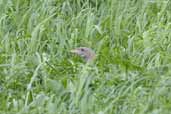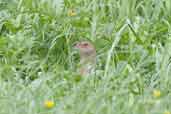
Although the world population is estimated at between 1.7 and 3 million singing males, it is classified as Near Threatened. The concern is that the changes in agricultural practice that have pushed the species to the edge of extinction in places like Britain will take place in Eastern Europe and Russia. Paradoxically the abandonment of some agricultural areas in these regions might also lead to meadows being overgrown with scrub and woodland which is also bad news for the Corncrake.

They are much easier to hear than to see and the male makes a loud rasping noise like running your finger along a comb. Locals on Iona, where these photos were taken, sometimes complain that they make such a racket at night that it is difficult to sleep.
That said, while I was feeling very pleased with myself having spotted this tiny head in a field of grass, a couple came along the road where I was standing to tell me that there was a Corncrake right out in the open beside Iona Abbey. Things like this happen when you have a camera and a large lens. It's not quite "gripping" but the effect is similar. Needless to say, when I got back to the Abbey, the corncrake was calling away but impossible to see.
There is a page on the corncrake at the Birdlife International Website.
| Previous Page | Back to Index | Next Page |